| Clan Watson | |||
|---|---|---|---|
 | |||
| Motto | Insperata Floruit[2] (It has flourished unexpectedly[3]) | ||
| Profile | |||
| Region | Lowlands | ||
| District | Lothian | ||
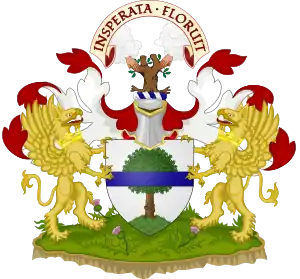 | |||
| Clan Watson no longer has a chief, and is an armigerous clan | |||
| Historic seat | Saughton House[4][5] | ||
| Last Chief | James Watson of Saughton | ||
| Died | 1823 | ||
| |||
Clan Watson is a Scottish clan that is recognised as such by the Lord Lyon King of Arms.[7][8][6] The clan does not currently have a chief recognised by the Court of the Lord Lyon.
The name Watson is derived from Watt, a diminutive form of the personal name Walter, with the addition of the patronymic suffix " -son". The name Watson is believed to have been introduced to Scotland in the early 11th century, during the reign of Edward the Confessor.[9][1] However, being wide spread and patronymic, has no single origin.
According to the National Records of Scotland in 2021, Watson is the 19th most common surname in Scotland.[10]
Origins and history
Watson of Cranston
In 1384 Robert II re-granted the lands of Cranstonriddel to William Watson with an entail to his heirs male, failing which to the heirs of Alexander de Moravia.[11] In 1407, William Watson of Cranston obtained a Crown charter of the estates of Traquair and Shillinglaw having purchased them from the Maitlands.[11] in 1409 the Maitlands granted annual-rents of Griestoun in Peeblesshire, to Marion de Craigie and her son William Watson.[11]
A John Watson is recorded owning lands in Edinburgh in 1392.[11] Early Scottish records note that Thomas Watson of Stenhous was party to an inquest near Falkirk in 1426.[1] Moray records refer to "Sir Donald Watsone" in 1493.[1]
The Watson of Saughton
The chiefly line of Watson in Scotland were the Watsons of Saughton.[11] Richard Watson is recorded owning the property of Saughton House in 1537.[11]
David Watson of Saughton (1637-1685) was admitted to The Society of Writers to Her Majesty's Signet on 1 June 1655, having been apprenticed to Harry Osburn, and served as Treasurer of the society between 1662-1682.[12]
The last known Clan Chief recognised by Lord Lyon King of Arms was James Watson Esq. of Saughton (1781-1823) who matriculated arms in 1818, within which was stated as being "Chief of the name in Scotland" and "descended in the direct male line from Richard Watson of Saughton, proprietor of those lands in A.D. 1537".[8][13][14]

The father of James Watson Esq. of Saughton, Charles Watson of Saughton was stated as being "Chief of the name in Scotland" within the contemporary publication "Antient and Modern State of the Parish of Cramond" written by John Philip Wood and published 10 years before the death of Charles Watson in 1794.[16]
The direct line of James Watson Esq. of Saughton ended when his daughter Helen Watson married Sholto John Douglas, 18th Earl of Morton.[17][18][19][20]
By the 19th Century Watsons were considerable landowners around the Edinburgh and Midlothian area.[21]
The Watsons as a Sept
The name Watson is recognised as a sept of both Clan Buchanan[22] and Clan Forbes.[23] The association to Clan Buchanan is through the MacWatties of Luss, who were a cadet branch of the Buchanans of Leny,[24] and the association with the Forbeses is due to the historical presence of a large Watt kin group in Forbes lands in Aberdeenshire.[25]
Historic seat
The historic seat of Clan Watson is Saughton, Midlothian.
The name 'Saughton' (referred to anciently as 'Salectuna'[26]) most likely comes from the Scots word 'Sauch' which in turn may derive from the Gaelic word 'Saileach' which means willow.[27]
Sauchton first appears in the records with the formation of Holyrood Abbey in 1128, being amongst the lands given by King David I of Scotland to the Abbey as "the town of Sauchton and its several divisions".[26][28]
Robert, Commendator of Holyrood Abbey, granted a charter of feu farm of six oxengates of the town and lands of Saughton, in the Regality of Broughton, in favour of Janet Stenhope relict (widow) of Richard Watson of Saughton, in liferent, and his son James Watson in fee, in the year 1537, having resumed ownership of the lands after the family had been dispossessed of them for a hundred years.[29][30]
Saughton House (Old Saughton House) was located 1 mile South of Corstorphine and was passed down through the descendants of Richard Watson until James Watson (Grandfather of the last known Chief of the Watson Clan) who purchased Cammo House in 1741 for £4252, 10s and changed the name to "New Saughton".[31]
Mr. W. Traquair Dickson, a solicitor, who later owned Old Saughton House stated, "A good many alterations on the house were made, evidently about the end of the seventeenth or early in the eighteenth century. The Watsons of Saughton were then wealthy and prominent people."[32]
In 1918 the house was destroyed by fire[33] and was later demolished to be replaced with a school and today is now a housing estate.[34]
 Old Saughton House 1888
Old Saughton House 1888 Old Saughton House following fire in 1918
Old Saughton House following fire in 1918
Notable individuals associated with Clan Watson
Major-General David Watson
Major-general David Watson (1704–1761)[35] was a Scottish Officer of the British Army, serving in the Royal Engineers. He was the son of Robert Watson of Muirhouse, descendants of the ancient family of Saughton.[36] David fought in multiple battles during the War of the Austrian Succession and the Jacobite Rising, including the Battle of Culloden. However is most noted for his contributions to the first Ordinance Surveys of Great Britain[37][38][39]
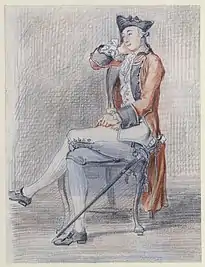 Col. David Watson by Paul Sandby (c. 1750)
Col. David Watson by Paul Sandby (c. 1750)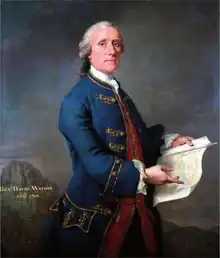 General David Watson by Andrea Soldi
General David Watson by Andrea Soldi
Captain (Royal Navy) Charles Hope Watson
Charles Hope Watson (1786-1836) was the son of Charles Watson Esq. of Saughton, and younger brother of the last known Chief of Clan Watson, James Watson Esq. of Saughton. He is listed within The Trafalgar Roll,[40] having served as an 18 year old Midshipman aboard HMS Defence during the Battle of Trafalgar under the command of Capt. George Johnstone Hope.[41] Charles also served upon frigate HMS Unité as a Lieutenant, under the command of Captain Patrick Campbell during the capture of three Italian brigs in the Adriatic in 1808, and upon promotion to the rank of Captain in the Royal Navy captained both HMS Arachne, an 18 gun Cruiser, and HMS_Talbot_(1824) a 28-gun, Atholl-class frigate.[42]
Clan Watson Tartan
The Watson tartan was designed in 1932 by Rev. Mhuir Watson, and is registered with the Scottish Register of Tartans.[43]
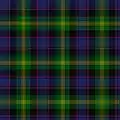 Watson tartan, 1932
Watson tartan, 1932

Watson Heraldry and Clan Branches
David Watson of Saughton first recorded the chiefly arms in 1672, being "argent, an oak-tree growing out of a mount in base proper, surmounted of a fess azure."[11] Later, in 1818, his descendent, James Watson of Saughton recorded the arms with Supporters.[11] The Arms of John Watson are those of David's second brother.
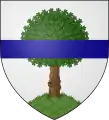 Watson of Saughton
Watson of Saughton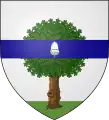 Arms of John Watson
Arms of John Watson
Five other early arms were recorded between 1672–75, those of the Watsons of Croslatt, the Watsons of Glentarkie (near Strathmiglo), Alexander Watson Bailie of Dundee; Andrew Watson, a merchant in Aberdeen; and Andrew Watson, merchant in Peterhead.[44]
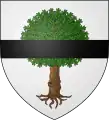 Watson of Croslatt
Watson of Croslatt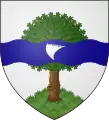 Watson of Glentarkie
Watson of Glentarkie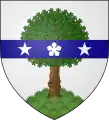 Alexander Watson, Bailie of Dundee
Alexander Watson, Bailie of Dundee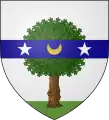 Andrew Watson, Aberdeen
Andrew Watson, Aberdeen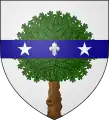 Andrew Watson, Peterhead
Andrew Watson, Peterhead
The Arms of the Watsons of Muirehouse were registered in 1722.[44] They were the Watsons of Damhead before they purchased the barony of Muirhouse from the Hunters some time after 1697.[45] Muirhouse was later sold by Lieutenant-Colonel Robert Watson to William Davidson in 1776.[45] Major-General David Watson was Robert Watson of Muirhouse's son.
The arms of George Watson, a merchant in Edinburgh, were registered in 1739.[44] George Watson was a philanthropist and the founder of George Watson's College, Edinburgh. Recent research has revealed that part of his fortune was acquired in the transatlantic slave trade.[46][47]
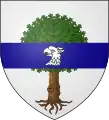 Watson of Muirhouse, 1722
Watson of Muirhouse, 1722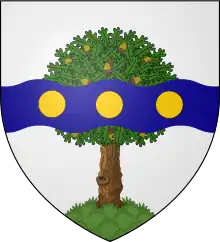 George Watson, Edinburgh, 1739
George Watson, Edinburgh, 1739
The Watsons of Neilsland registered their arms in 1871[44] and in 1895 John Watson of Neilsland became the first baronet of Earnock. Sir John was a coal tycoon and amassed considerable wealth, purchasing and combining the estates of Neilsland and Earnock in 1871 and 1873 respectively into an estate of about 2000 acres.[48]
The arms of Sir James Watson of Broomknowe were registered in 1872.[44] Sir James was Glasgow's first stock broker, the Lord Provost of Glasgow from 1871 to 1874 and was knighted in 1874.[49][50]
The arms of William Watson, Lord Watson, were registered in 1880,[44] at the same time he has ennobled as Baron Watson of Thankerton. Lord Watson was a conservative member of parliament for Glasgow and Aberdeen Universities 1876–1880, Solicitor General for Scotland 1874–1876 , Lord Advocate 1876–1880, appointed to the Privy Council in 1878 sat on the Judicial Committee of the Privy Council.[51]
The arms of the Watsons of Langley House were registered in Scotland in 1881.[44] In 1881 James Watson, of Langley House became High Sheriff of Buckinghamshire.[52]
The arms of the Watsons of Shielhill and Terpersy were possibly registered some time before 1855.[53] The seat of this branch was Shielhill House near Kirriemui, Angus.[53] This branch are also of the Watsons of Tipperty (near Aberdeen) and was notably represented by Lieutenant-General Archibald Watson, Colonel of the 1st Bengal Cavalry, H.E.I.C.S.[53]
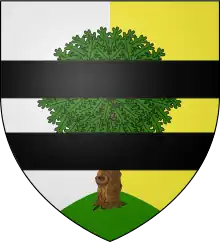 Watson Baronets of Earnock, also known as Watson of Neilsland
Watson Baronets of Earnock, also known as Watson of Neilsland James Watson of Broomknowe, Lord Provost of Glasgow
James Watson of Broomknowe, Lord Provost of Glasgow
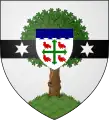 Watson of Langley House, near Slough, 1881
Watson of Langley House, near Slough, 1881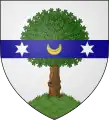 Watson of Shielhill and Terpersy
Watson of Shielhill and Terpersy
The arms of William Livingstone Watson were registered in 1887.[44] William joined the East India merchants and was an astronomer. He purchased the estate of Ayton House in Perthshire.[54]
The arms of the Watson of Braco Castle, Perthshire were registered in 1903.[44] Sir Remy Watson of Braco Castle acquired the Rembrandt painting Anna and the Blind Tobit which his son, Denis Watson, sold to the National Gallery in 1926.[55]
The arms of Alan Watson, Falkirk were registered in the early 2000s.[56] Alan Watson was regius professor of forensic medicine at Glasgow University.[57] His arms offer an insight into how modern heraldry incorporates the identity of a person: the hourglass refers to his professional body, the Faculty of Actuaries, and the "fess brettessed the crenelles semicircular" (the purple buttressed line crossing the oak) represents the binding between stamps and his philatelic interests.[56]
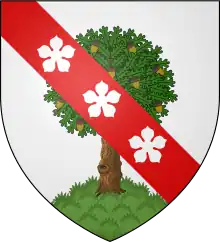 Arms of William Livingstone Watson, London 1887
Arms of William Livingstone Watson, London 1887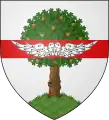 Watson of Braco Castle
Watson of Braco Castle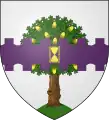 Arms of Professor Alan Watson, Falkirk; Reg. early 2000s
Arms of Professor Alan Watson, Falkirk; Reg. early 2000s
The Watson Mazer
The Watson Mazer[58] is the earliest in the sequence of Scottish standing mazers, featuring the coat of arms of David Watson of Saughton. A hallmark may relate to the goldsmith Adam Leys. Chemical analysis places it in the early 16th century.[59] It is constructed of a maple wood bowl with a silver-gilt band, resting on a silver stem and an inscribed trumpet-shaped foot.
On the foot of mazer is the inscription "TYNE GEIR TYNE LITIL TYNE HONOVR TYNE MUCKIL TYNE HART TYNE AL" which translates to "Lost wealth lost little, lost honour lost much, lost heart lost all".
The Watson Mazer is on display as part of the Silver Treasury, level 5 of the Scotland Galleries in Edinburgh.[60]
 The earliest in a series of Scottish Standing Mazers from the early 16th Century.
The earliest in a series of Scottish Standing Mazers from the early 16th Century.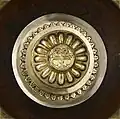 Engraved centre with the arms and initials of David Watson of Saughton.
Engraved centre with the arms and initials of David Watson of Saughton.
Clan Watson Today
The Clan Watson Society has started a campaign to find the surviving heirs of the Watsons of Saughton,[61] and has been working closely with both Clan Buchanan society and Clan Forbes in regards to their use of Watson as a sept.[62]
Notes and references
- 1 2 3 4 5 Way of Plean, George (1994). Collins Scottish clan & family encyclopedia. Glasgow: Harper Collins. p. 469. ISBN 9780004705477.
- ↑ A system of heraldry, speculative and practical, with the true art of blazon, according to the most approved heralds in Europe by Alexander Nisbet (Published 1816) p.22 - OCLC 181837040
- ↑ Elvin, Charles Norton (1860). A Hand-book of Mottoes Borne by the Nobility, Gentry, Cities, Public Companies, &c. Bell and Daldy.
- ↑ "Edinburgh, Broomhouse Crescent, Saughton House | Canmore". canmore.org.uk.
- ↑ "SAUGHTON HOUSE". 2 February 2018.
- 1 2 "Watson". COSCA.
- ↑ "MyClan.com : A-Z List of the Clans". 10 March 2007. Archived from the original on 10 March 2007. Retrieved 8 October 2023.
- 1 2 Register of the Lyon Court (Vol. 2, Folio 178, 1818) - Available via ScotlandsPeople.gov.uk
- ↑ "Watson Name Meaning, Family History, Family Crest & Coats of Arms". HouseOfNames. 1 January 2000.
- ↑ Team, National Records of Scotland Web (31 May 2013). "National Records of Scotland". National Records of Scotland.
- 1 2 3 4 5 6 7 8 R., STODART (1881). SCOTTISH ARMS, BEING A COLLECTION OF ARMORIAL BEARINGS A.D.1370-1678 Reproduced in Facsimile from Contemporary Manuscripts WITH HERALDIC AND GENEALOGICAL NOTES, VOLUME SECOND. Edinburgh: WILLIAM PATERSON. p. 242. Retrieved 5 October 2023.
- ↑ A History of the Society of Writers to Her Majesty's Signet (Published 1890) - OCLC 5043324
- ↑ The Book of the Old Edinburgh Club. -- Vol. 1-35 (1908-1985) p.194 OCLC 887931989
- ↑ "Stirnet". www.stirnet.com.
- ↑ "Charles Watson, Esq. (1740–1804) and His Wife, Margaret Carnegie (1756–1793), with Two of Their Children, James (1781–1823) and Anne (1782–1800), in a Landscape | Art UK". artuk.org.
- ↑ Antient and Modern State of the Parish of Cramond by John Philip Wood (Published 1794) p.63 - OCLC 953326100
- ↑ The Heraldry of the Douglases by Johnston, G. Harvey (Published 1907) p.80 - OCLC 5165924
- ↑ Armorial families; a directory of gentlemen of coat-armour by Arthur Charles Fox-Davies (Published 1970) p.560 ISBN 0804807213
- ↑ "Clan Watson - The Clan Chief: The Clan Watson Society". clanwatson.org.
- ↑ A Midlothian Village - Manuscript by G. Upton Selway (dated 1890) p.39
- ↑ Scottish rural society in the sixteenth century by Sanderson, Margaret H. B (Published 1982) p.143 - ISBN 0859760278
- ↑ "Clan Buchanan is comprised of over 50 surnames, here is the official list". The Clan Buchanan. Retrieved 9 October 2023.
- ↑ "Clan Forbes Septs". The Clan Forbes Society. Retrieved 9 October 2023.
- ↑ The Clans, Septs and Regiments of the Scottish Highlands by Adam, Frank (Published 1952) p.296
- ↑ The Clans, Septs and Regiments of the Scottish Highlands by Adam, Frank (Published 1952) p.304
- 1 2 The Scottish Historical Review Vol. XIV, No. 56 (Published 1917) p.312
- ↑ "Saughton Park History". saughton-park.
- ↑ "The Lands and Manor House of Gorgie".
- ↑ The Book of the Old Edinburgh Club Vol. 3 (Published 1910) p.194 OCLC 781145345
- ↑ A Midlothian Village - Manuscript by G. Upton Selway dated 1890 (Page 38)
- ↑ Memoirs of the life of Sir John Clerk of Penicuik Publications of the Scottish Historical Society - Volume XIII (Published 1892) p.274 OCLC 41962846
- ↑ Old Edinburgh Club (1910). The book of the Old Edinburgh Club. Vol. 3. Allen County Public Library Genealogy Center. Edinburgh: Edinburgh : The Club. p. 194.
- ↑ The Daily Record, 2 February 1918
- ↑ HouseandHeritage.org - Saughton House
- ↑ Biography of Major-General David Watson from Insperata Floruit Newsletter (Published 2022)
- ↑ Ancient and Modern State of the Parish of Cramond by John Philip Wood (Published 1794) p.27 OCLC 953326100
- ↑ Baigent, Elizabeth (2008). "Watson, David (1713?–1761), military surveyor and engineer". Oxford Dictionary of National Biography (online ed.). Oxford University Press. doi:10.1093/ref:odnb/28834. (Subscription or UK public library membership required.)
- ↑ Watson, David (1713?–1761), military surveyor and engineer Hewitt, Rachel (2010). Map of a Nation: A Biography of the Ordnance Survey. London: Granta Books ISBN 1847084524, 9781847084521
- ↑ Ordnace Survey - Map Makers to Britain Since 1791 By Tim Owen and Elaine Pilbeam (Published 1992) ISBN 0319004988
- ↑ The Trafalgar Roll p.173
- ↑ The National Archives "Trafalgar Ancestors" Catalogue reference: ADM 36/15942
- ↑ Marshall, John. Royal Naval Biography – via Wikisource.
- ↑ "Tartan Details - The Scottish Register of Tartans". www.tartanregister.gov.uk. Retrieved 9 October 2023.
- 1 2 3 4 5 6 7 8 9 Paul, James Balfour (1903). An Ordinary of Arms Contained in the Public Register of all Arms and Bearings in Scotland (PDF) (2nd ed.). Edinburgh: William Green and Sons. pp. 369–372.
- 1 2 "Muirhouse (site of) | Castle in Edinburgh, Midlothian | Stravaiging around Scotland". www.stravaiging.com. Retrieved 8 October 2023.
- ↑ "Heritage - George Watson's College". www.gwc.org.uk. Retrieved 11 October 2023.
- ↑ "The Legacy of George Watson - George Watson's College". www.gwc.org.uk. Retrieved 11 October 2023.
- ↑ Dailyrecord.co.uk (15 June 2011). "Past of Sir John Watson 1st Baronet of Earnock is recalled". The Daily Record. Dailyrecord.co.uk. Retrieved 7 October 2023.
- ↑ "TheGlasgowStory: Sir James Watson". www.theglasgowstory.com. Retrieved 7 October 2023.
- ↑ Biographical Sketches of the Hon. the Lord Provosts of Glasgow: With Appendix. Glasgow: J. Tweed. 1883. pp. 205–209.
- ↑ Rigg, James McMullen (1901). . Dictionary of National Biography (1st supplement). Vol. 3. p. 508.
- ↑ "Page 979 | Issue 24945, 2 March 1881 | London Gazette | The Gazette". www.thegazette.co.uk. Retrieved 7 October 2023.
- 1 2 3 Peter, David MacGregor (1856). The Baronage of Angus and Mearns (PDF). Edinburgh: Oliver and Boyd. pp. 353–354.
- ↑ "William Livingstone Watson". academic.oup.com. 12 February 1904. Retrieved 7 October 2023.
- ↑ RDK. "Anna and the blind Tobit, ca. 1630". Netherlands Institute for Art History (RKD). RDK. Retrieved 7 October 2023.
- 1 2 Scotland, Heraldry Society of (23 December 2022), WATSON, Alan, retrieved 8 October 2023
- ↑ "Alan Watson Professor of forensic medicine whose Christian values guided him throughout his life". The Herald. 28 November 2001. Retrieved 8 October 2023.
- ↑ The Watson Mazer on Insperata Floruit
- ↑ Chemical analysis of the Cadboll Cup and the Watson Mazer by Hugh McKerrell (Published 1971)
- ↑ "The Museums Journal". The Museums Journal. Museums Association. 47–48: 129. 30 November 2009. Retrieved 22 October 2023.
the Royal Scottish Museum has acquired the Watson Mazer
- ↑ "Council of Scottish Clans & Associations". www.cosca.scot. Retrieved 30 September 2023.
- ↑ "Clan Watson to Develop Sept Program with Clan Buchanan and Clan Forbes". COSCA. Retrieved 13 October 2023.